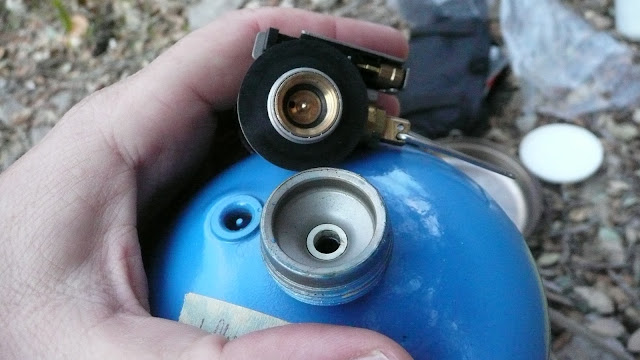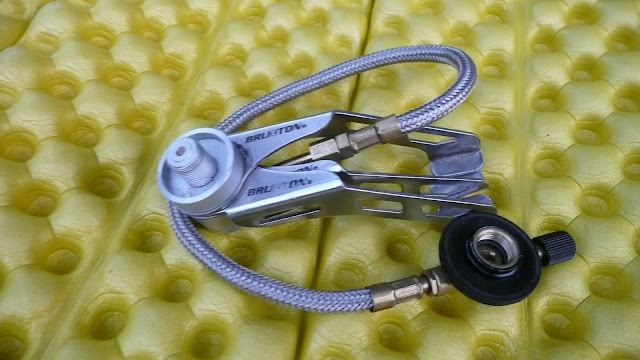I've described 100% propane as the "Holy Grail" of cold weather backpacking for canister stoves. Why? Take a look at the below table of the vaporization points of the gases used for canisters stoves.
Boiling (vaporization) point
n-butane -0.5C 31F
isobutane -12C 11F
propane -42C -44F
If temperature falls below the values indicated below, you'll have a liquid not a gas. Ever try to run a
gas stove on
liquid fuel? Good luck. Propane has the lowest vaporization point by far. When other fuels are rendered useless by cold, propane will still be good to go.
So, why don't backpackers all just use 100% propane in cold weather? Well, two reasons: 1) most stoves designed for 100% propane are big kludgey (by backpacker standards) affairs that were never intended to be carried on one's back and 2) 100% propane has some seriously high vapor pressure. Those little thin walled backpacking canisters are not going to safely hold something like 100% propane. You have to carry a heavy duty canister.
Well, we can't do anything about the heavy duty canister side of things (unless you can find a
Bernzomatic PowerCell), but what if you could lose the big kludgey car camping stove? I mean, that's half the battle, right?
How? With a
Kovea LPG (propane) Adapter which I've covered previously. In this post, I'd like to talk about the practicalities of 100% propane for backpacking.
First, when I say propane, what's typically available that is portable?
 |
| A 100% propane cylinder |
100% propane canisters typically look like the above (although they're usually green). Typically such canisters contain 16.4oz/465g of 100% propane. Bernzomatic brand contains 16.92/479g for some reason. The connector is the same on 14.1oz/400g propane cylinders commonly used for propane torches.
Let's have a look at the female connector on the tank.
 |
| The female connector on a typical propane cylinder |
If you compare that connector to the male connector on a backpacking stove, you'll quickly see that the two aren't compatible.
 |
| A male connector on a backpacking stove (top) and a female connector on a propane canister. |
How to bridge the gap? An adapter.
 |
| A Kovea LPG (propane) adapter |
The adapter threads onto the top of the propane cylinder.
 |
| A propane cylinder with a propane adapter. |
Our backpacking stove then screws into the adapter.
 |
| A Markill Hot Rod backpacking stove in use with a 100% propane cylinder |
What's the problem with this set up? Well, it's just a tad tippy for one. And a bit of a trick to shield from wind.
THIS SET UP IS DANGEROUS AND IS NOT RECOMMENDED.
 |
| A backpacking canister stove atop a 100% propane cylinder. This configuration is DANGEROUS and is not recommended. |
So, let's change it from an "upright" configuration (as shown above) to a "remote" configuration. First, we'll need a Brunton Stove Stand (or the equivalent).
 |
| A Brunton Stove Stand |
There. Well, that's a little better. But still, that cylinder might fall over. This set up is unstable. Not recommended.
 |
| A "remote" set up with a backpacking stove and 100% propane. This is not stable and is not recommended. |
Couldn't we just lay the propane cylinder on its side? I mean, wouldn't that be a lot more stable?
 |
| A backpacking stove running with a propane cylinder laying on its side |
Indeed we can, and with 100% propane, it works. Be aware that when you lay a canister on its side, you are sucking liquified propane out of the canister. I'm running in weather that is about 45F/7C here, which is plenty warm for propane to vaporize before it gets to the burner. At some point, as the temperature drops, you'll have to shunt heat from the flame to the fuel in order to maintain vaporization. I really don't know at what temperature you will need to start shunting heat. I do know that propane vaporizes at -42C/-44F, so as you approach about -37C/-34F, you'll definitely have to start shunting heat to the fuel to maintain vaporization, but I suspect you may have to shunt heat even before that.
So, there you have it, there's how to use 100% propane with backpacking stoves.
Now, even if we eliminate the bulky, heavy car camping stoves, just having to carry that big, heavy duty 100% propane cylinder is pretty heavy. Why would anyone want to carry it?
Here are a few possible reasons for going to the trouble to carry 100% propane:
1. Cold weather -- Mechanical Reliability. Gas stoves typically are more reliable than liquid fueled stoves. Gas stoves clog less and have no pump to fail. One might bring propane so that one could continue to use in cold weather the more reliable gas stove.
2. Bad weather -- Safety. OK, you're on the mountain. A storm hits. What? You're going to go outside to cook?
Are you nuts? In a storm? You tired of life or something? Yes, I know the instructions on your stove say "never cook indoors." I'm sure the corporate lawyer who wrote that really feels your pain right now. Look, you've got to cook up there on that mountain; Mr. Lawyer doesn't. Cook inside your shelter. It's the only reasonable alternative. Gas stoves don't require priming. BIG advantage if you're tent-bound even for only one meal.
3. Cold weather -- Functionality. Propane will work at temperatures way below the temperatures that the gas blend in a typical backpacking canister will work in. One might bring propane simply because that's the only gas that will work when it gets cold enough. Some people prefer gas stoves (or hate liquid fueled stoves) that strongly. Gas stoves typically are more fuel efficient and have much better flame control.
4. Cost. At least in the US, a standard threaded 450g backpacking canister of gas typically costs $9.00. A 465g cylinder of propane is $2.56 if you buy a two pack at Wal-Mart. An adapter and some cheap propane could be really handy for a night before the trip trailhead camp. You use your backpacking stove, but you run it on cheap propane that first night at the trailhead. In the morning, you hit the trail with a 100% full backpacking canister, which, depending on the trip, might allow you to carry a smaller canister or not have to take a second canister.
Even if you don't see an immediate application, it's there if you ever need it: 100% Propane for Backpacking.
Now, words of warning: Propane has higher vapor pressure than the gas blends used in backpacking canisters. Higher pressure means higher danger. You could get flame "lift off" where the flame rises up, away from the burner. In that situation, the flame may go out while the gas is still flowing. You've now got a hot stove with no flame but the gas is still coming out. This could get ugly. Gas + air + heat = KABOOM! So, be careful because:
Propane is a highly flammable and potentially explosive gas.
Backpacking stoves are not designed to operate on 100% propane. Use at your own risk. Risk includes loss of property, serious bodily injury, and death.
Here are some tips. These tips might reduce the risk, but no matter how many safety tips you incorporate, working with 100% propane in a backpacking stove is dangerous. Period.
a) Hook everything up and listen for any sound of escaping gas. If you hear any gas, STOP. Correct the leak before proceeding.
b) Start with the gas turned down low
c) Turn things up slowly
c) NEVER open the valves fully
In this set up, you are the safety device. The set up has no inherent safety mechanism. This set up is inherently dangerous, and you are deliberately choosing to do something dangerous if you copy what I have done.
Adapters open up a whole new world in terms of fuel and stove combinations that can be used. Adapters also open up a whole new world of hurt if you exceed the limitations of a particular set up. Just because you
can hook up something up doesn't mean it's a good idea. Above all else,
be careful.
Thanks for joining me on another Adventure In Stoving.
HJ




